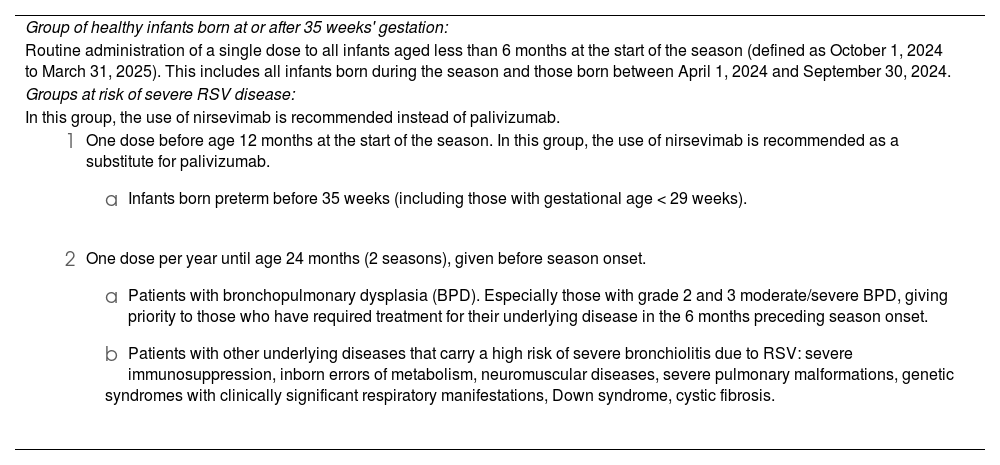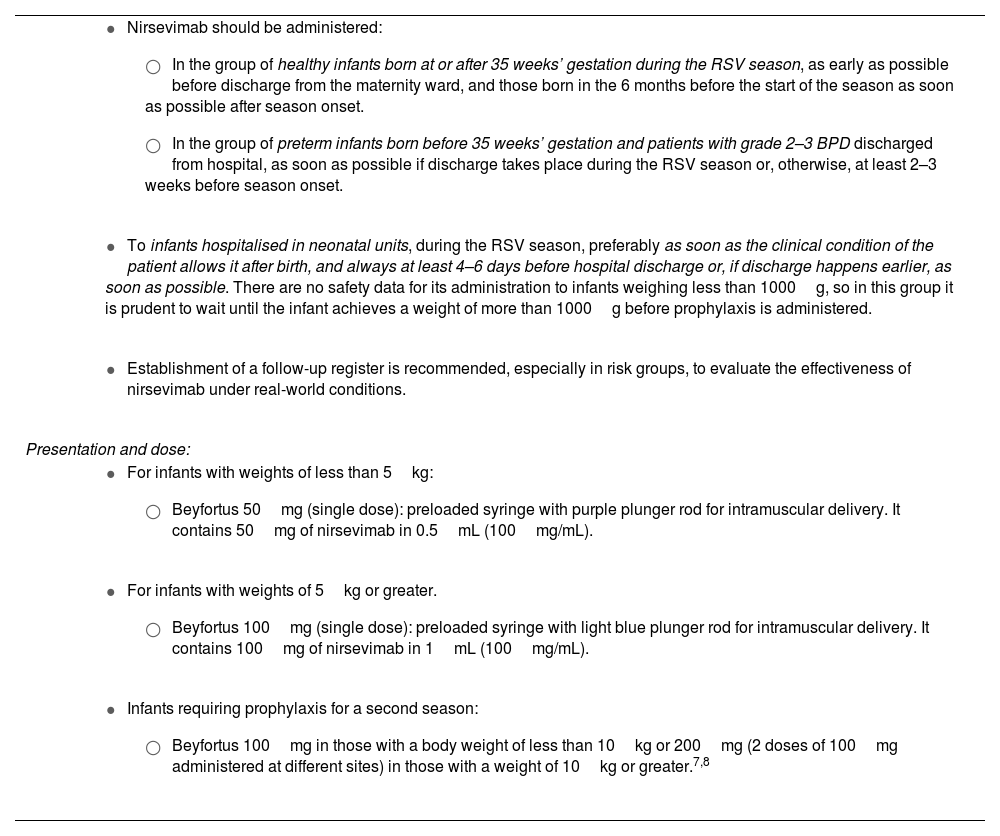Respiratory syncytial virus (RSV) is one of the leading causes of severe respiratory disease and hospital admission in healthy infants without known risk factors. Monoclonal antibody prophylaxis has been available for more than 20 years, but due to their high cost and short half-life, they have only been used in at-risk neonates and infants. Recently, monoclonal antibodies with higher potency, longer half-life and lower cost have become available, allowing their universal use not only in high-risk groups but also in healthy neonates and infants. Nirsevimab, a new long-acting monoclonal antibody, has exhibited a high efficacy and a good safety profile in clinical trials,1–3 and its use was approved in the European Union on November 3, 2022. On May 9, 2023, the Ministry of Health of Spain approved the recommendations for the use of nirsevimab during the 2023–24 epidemic season in infants at high risk of severe RSV disease, and on July 12, 2023 approved its routine use in infants aged less than 6 months (born between April 1, 2023 and March 31, 2024) at the beginning or during the RSV season. In September of 2023, the Sociedad Española de Neonatología (SENeo, Spanish Society of Neonatology) published its recommendations.4
To assess the effectiveness of this approach, a Joint Vaccination Register was established for the COVID-19 vaccination strategy and a working group formed in the framework of the Vaccination Strategy, Registration and Evaluation Committee to evaluate the RSV vaccination/immunisation programme in the paediatric and adult populations, taking into account currently available and soon to be authorised vaccines and monoclonal antibodies for the prevention of medically attended RSV. The excellent outcomes observed in this evaluation, with a mean immunisation coverage of over 90% in infants born during the season and 87% in infants born before season onset, with an effectiveness against RSV-related hospitalisations of around 80% and an excellent safety profile, motivated the issuing of new recommendations for prophylaxis against RSV infection for the 2024–2025 season in Spain by the Interterritorial Council of the Ministry of Health, which were approved by the Public Health Commission on March 14, 2024 and the Vaccination Strategy, Registration and Evaluation Committee on February 29, 2024 and reviewed by the Working Group on Paediatric RSV of the Vaccination Strategy, Registration and Evaluation Committee, essentially leaving unchanged the previous recommendations issued for the 2023-2024 season.5
In light of the excellent results of the universal prophylaxis campaign in the 2023–2024 season, the SENeo recommends maintaining the same universal prophylaxis schedule with monoclonal antibodies for the 2024–2025 season, including a modification in the dosage of nirsevimab for patients who require its administration for a second season,6 as can be seen in Tables 1 and 2.
Indications for immunoprophylaxis against severe RSV infection, 2024–2025 season.
| Group of healthy infants born at or after 35 weeks' gestation: |
| Routine administration of a single dose to all infants aged less than 6 months at the start of the season (defined as October 1, 2024 to March 31, 2025). This includes all infants born during the season and those born between April 1, 2024 and September 30, 2024. |
| Groups at risk of severe RSV disease: |
| In this group, the use of nirsevimab is recommended instead of palivizumab. |
|
|
RSV, respiratory syncytial virus.
Additional considerations to take into account for immunoprophylaxis with nirsevimab.
|
|
|
| Presentation and dose: |
|
|
|
BPD, bronchopulmonary dysplasia.






